and special mention to Antti Pihlajasalo ("IM2429"), who devised Black's wonderful defence.
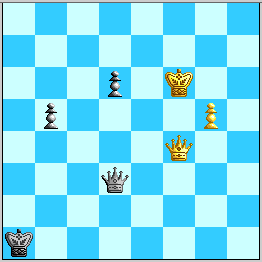
Diagram 1. The defense Kasparov planned to beat---but could he?
and special mention to Antti Pihlajasalo ("IM2429"), who devised Black's wonderful defence.

Diagram 1. The defense Kasparov planned to beat---but could he?
55. g6 Qc3+
56. Kf7 Qc7+
There was some initial excitement about the possibility of 56...Qc4+ drawing, but 57. Qxc4 bxc4 is EGTB+/- #25. Careful counting of the advance of both pawns, with White having a good Qd4! blocking move at the key step, showed at the time that this does not work. However, now 57. Kg8? Qc4+! is an obvious draw---a nifty switch from Kg8 being the winning move when White's Queen is on f5!
57. Kf8

Diagram 2, Black to play. Which Queen check is the hardest to meet?
Black must continue checking, as White is well-placed to support the g7 advance, so Black had little choice up to here. Now 57...Qd8+ is ineffectual because of 58. Kg7 Qe7+ (58...b4 59. Qxb4 is EGTB+/- #51, but 59. Kh7 looks even better) 59. Qf7 (or 59. Kh6 Qe6 60. Qf1+ Ka2 61. Qxb5 EGTB+/- #78) Qe5+ 60. Kf8! Qh8+ 61. Ke7 Qe5+ 62. Kd7 b4 63. g7 Qb5+ 64. Kc8 Qa6/c6/c5+ 65. Kb8 Qb6+ (65...Qb5+ 66. Qb7 Qe8+ 67. Qc8 Qb5+ 68. Ka7+/-) 66. Qb7 Qd8+ 67. Qc8! Qb6+ 68. Ka8 Qa5+ 69. Kb7 Qd5+ 70. Kb8! Qb5+ 71. Ka7+/-, a nifty way to exploit Black's King at a1. Hence Black has two main choices.
A. 57…Qc8+ 58.Kg7, and now:
A1) 58...Qc4 59.Qf6+ Ka2 60.Qf7 d5 61.Kf8 b4 62.Qf2+! Ka1 63.g7 Qc8+ 64.Kf7 Qd7+ 65.Kg6 Qe8+ 66.Qf7 Qe4+ 67.Qf5 Qe8+ 68.Kh7 Qe7 69.Qf4 Qd7 70.Qf1+ Kb2 71.Kh8, is winning for White.
A2) 58...Qc3+ 59.Kh6! with:
A21) 59...Qh8+ 60.Kg5, and now:
A211) 60...b4 61.Qf1+ Ka2 (61...Kb2 62.Qf6+, wins for White) 62.Qf7+ b3 63.g7 Qd8+ 64.Kg6, White wins.
A212) 60...Kb1 61.Qf6! Qg8 62.g7 d5 (or 62...b4 63.Qf8 Qd5+ 64.Qf5+, winning) 63.Qf8, and White wins.
A22) 59...Qh3+ 60.Kg5 Qg2+ 61.Kf6 Qb2+ 62.Kf5 Qc2+ 63.Qe4 Qc8+ 64.Qe6 Qc2+ 65.Kf6 Qc3+ 66.Kf7 Qc7+ 67.Kg8 b4 68.Qf6+ Kb1 69.g7 d5 70.Kf8 Qc8+ 71.Kf7 Qc7+ 72.Kg6 Qg3+ 73.Qg5 Qd6+ 74.Kf5 Qd7+ 75.Kf4 Qc7+ 76.Kf3 Qc3+ 77.Kf2 Qc2+ 78.Kg1 Qd1+ 79.Kh2 Qc2+ 80.Qg2 Qh7+ 81.Kg1 Qg8 82.Qf1+ Ka2 83.Qf8, wins for White.
A3) 58...d5:
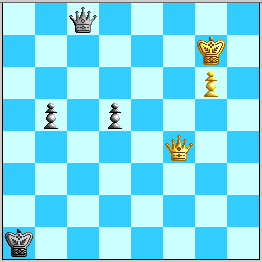
Diagram 3, White to play. The "Solnushka defense" doesn't work here.
Here I (KWR) originally gave 59. Kh6(?!) Qe6 60. Kg5 b4 61. g7 b3 62. Qa4+ Kb2 63. Qg4!, envisioning a beautiful "King dance" with 63...Qe5/e7+ 64. Kg6 Qe8+ 65. Kf6! Qd8+ 66. Kf7! Qc7+ 67. Kg6! (Black cannot reach e8 now), when (i) 67...Qd6+ 68. Kf5! Qd7+ 69. Kf4 Qc7+ 70. Kf3 Qc3+ 71. Kf2 Qc5+ 72. Kg2 Qc2+ 73. Kh1 Qh7+ 74. Kg1 Qb1+ 75. Kf2+/-, (ii) 67..Qd6+ 68. Kf5 Qd7+ 69. Kf4 Qf7+ 70. Kg3 Qg8 71. Qe2+ Ka3/c1 72. Qe7+/f1+ Ka2/c2 73. Qf8+/-, (iii) 67...Qc6+ 68. Kg5 Qc1+ 69. Kh5 Qh1+ 70. Kg6+/-, and (iv) 67...Qc2+ 68. Qf5! Qc6/g2+ 69. Kf7/h5+/- show White's main winning ideas---in lines where Black plays ...Qg8 Black is likewise betrayed by the d-pawn being on d5. However, here 63...Qf7! 64. Kh4 Qg8! throws a spanner in White's works, and White seems to be unable to win. Furthermore, 59. Kh6 b4!? may work for Black, as 60. g7 Qe6+ is annoying and 60. Qxb4 allows a perpetual. Peter Karrer found the right move, an option that may explain why Kasparov played 54. Qf4 not 54. Qf2:
59. Kf6!
The effectiveness of this move is magnified by Black's King being on a1, as shown by 59...Qf8+? 60. Kg5! and with no more chacks Black quickly goes down. Black has:
A31) 59...b4 60. Qxb4, and it doesn't require an EGTB server to see this is +/- after 60...d8/c6+ 61. Qe7/Kf7 Qb6+/c7+/d7+ 62. Kf7/Qe7 and Black cannot check on the f-file. (For the record, 60. Qxb4 is mate in 38 more moves, but drawn with Black's King on a2!)
A32) 59...Qd8+ 60. Kf5 and now:
A321) 60...b4 61. Qxb4 is still a quick loss.
A322) 60...d4 61. g7 d3 (61...Qd7+ 62. Kf6 wins---Black's b-pawn is no help compared to lines after 58...Qe4? in the actual game, and 61...Qc8+ 62. Kg5 d3 63. Qd4+ is +/-) 62. Qe5+ Kb1 63. Qxb5+ Ka1 64. Qa4+ Kb2 65. Qb4+ Ka1 66. Qa3+ Kb1 67. Qb3+ is the end.
A323) 60...Qd7+ 61. Kg5 d4 62. Qe5! Ka2 (62...Kb1 63. g7 Qd8+ 64. Kh5 d3 65. Qxb5+ wins as in A322) 63. g7 Qf7 64. Qf6 Qd5+ 65. Qf5 Qd8+ 66. Kg6 Qd6+ 67. Kh5 Qh2+ 68. Kg5 Qg2+ 69. Kf6 d3 70. Qe6 +- (Karrer).
A324) 60...Qc8+ 61. Kg5 d4 62. Qxd4+ EGTB+/- #29 is clear enough. (But with Black's King at b1 (loss in 59 at a2) it is drawn---confirming our impression during the game that Black could afford to lose the d-pawn on d4 but not with check.)
However, Antti Pihlajasalo as "IM2429" found over the weekend of Oct. 2-3 that Black's remaining check has many trappy possibilities:

Diagram 4. White to play and win.
White appears to polish this off by 59. Kh7 Qa7+! (59...b3 60. Qa4+! Kb2 61. g7 Qb7 62. Qh4! Qc7---only way to reach the a1/h8 diagonal to answer 63. Kh8---63. Qd4+ K-any 64. Kh8 +/-) 60. g7 b3 61. Kh8 b2 62. Qf6...
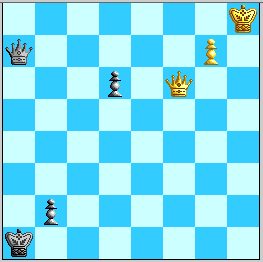
Diagram 5. Is this 1-0? No!
62...d5!! 63. g8=Q d4!!, and with no checks, White has no better than 64. Qg1+ b1=Q 65. Qxd4+ Qxd4+ 66. Qxd4+ Qb2 67. Qxb2+ Kxb2 Hoovered.
There was much discussion on the World Team Strategy Bulletin Board about whether White can win by 59. Kh7 Qa7+ 60. Qf7, but the final answer appears to be no:
60...Qe3! (60...Qd4? 61.Qf1+ Ka2/b2 62.Qe2+ Ka3 (best) 63.g7 Qh4+ 64. Kg6 Qg3+ 65. Kf7 Qf4+ 66. Ke8 Qg3/g5 67. Qa6+! Kb2 68. Qa7!! wins, as 68...b3 69. Qf7 Qe3/e5/b5+ 70. Kf8 Qb8+ 71. Qe8+/- is a sudden end, and other moves head into one form or another of the basic Qf7 win) 61.Qf1+ Ka2! 62.Qg2+, and now:
B11) 62...Ka1 63.g7 Qd3+ 64.Kh8 Qd4 65.Qf3! Qh4+ 66.Kg8 Qc4+ 67.Kf8 Qc8+ 68.Ke7 Qc7+ 69.Kf6 Qd8+ 70.Kg6 Qe8+ 71.Kh7 Qe7 72.Qf4 (the same winning maneuver as seen in Variation A1) 72…Qd7 73.Qf1+ Kb2 74.Qg2+ Ka1 75.Kh8, with a winning position for White.
B12) 62...Ka3 63.g7 Qd3+ 64.Kh8, and now:
B121) 64…Qc3 65.Qa8+ Kb2 66.Qd5 Qh3+ 67.Kg8 Ka3 (or 67...b3 68.Kf7 Qd7+ 69.Kf6 Qd8+ 70.Kg6 Qe8+ 71.Kh7 Qe7 72.Qd4+ Ka3 73.Kh8, and White wins, or 67...Kc3 68.Kf7 Qd7+ 69.Kg6 Qe8+ 70.Kh7 Qe7 71.Qf3+ Kc2 72.Qf4 b3 73.Kh8, also winning for White) 68.Kf7 Qd7+ 69.Kg6 Qe8+ 70.Kh7 Qe7 71.Qa8+ Kb2 72.Qf3 Qh4+ 73.Kg8 Qc4+ 74.Kf8 Qc8+ 75.Ke7 Qc7+ 76.Kf6 Qd8+ 77.Kg6 Qe8+ 78.Kh7 Qe7 79.Qf4, and White wins. Instead Black can try:
B122) 64...Qd4! 65.Qf3+, and now not:
B1221) 65...Kb2? 66.Kh7 Qh4+ 67.Kg6 Qc4 68.Qf7 Qg4+ (Alternatives lose. For example: 68...Qe4+ 69.Qf5 Qe8+ 70.Kh7 Qe7 71.Qf4, or 68…Qd3+ 69.Qf5 Qg3+ 70.Kf7, and White wins) 69.Kf6 Qh4+ (not 69...Qf3+ 70.Ke6 Qe3+ 71.Kxd6 Qd4+ 72.Kc6 Qe4+ 73.Kb5 Qd3+ 74.Kxb4, and White is winning) 70.Ke6 Qc4+ 71.Ke7 Qc7+ 72.Kf6 Qc3+ 73.Kf5 (73.Kg5 Qg3+ 74.Kf5 Qe5+ transposes) 73...Qe5+ 74.Kg4 Qe4+ 75.Kg3 Qe3+ 76.Kg2 Qe4+ 77.Qf3 Qg6+ 78.Qg3 Qe4+ 79.Kf1 Qc4+ 80.Kg1 Qg8 81.Qf2+ Kc3 82.Qf8, and White wins, but instead:
B1222) 65...b3! 66.Kh7 Qh4+ (66...Qa7 67.Kh6 Qb8 68.Qf8, and White wins) 67.Kg6 Qd8 (or 67...Qc4 68.Qa8+, winning) 68.Qf8, and Black holds a draw after 68…b2 69.Qxd8 b1=Q+ 70.Kf7 Qb3+! 71.Ke7 Qe3+ 72.Kd7 Qh3+! and Black holds. (Khalifman found during the game that in a related position with Black's King on b2, Queen on d8, and pawns on b3,d6 versus White's King on g6, Queen on f3, and pawn on g7, ...Ka3!! was the only way to hold.)
Go back to the diagram after 58...b4 and try to find a winning alternative to 59. Kh7 before looking below.
Note that on 59. Kh7, 59...Qa7+! was an important Zwischenzug to take away squares from White's Queen. White's winning idea is to "swish the Zwisch".

Diagram 6. Try again---White to play and win.
The solution is:
59. Qd4+! Ka2
59...Kb1 makes the main-line defense unplayable as b4 hangs with check, and is worse in other corresponding lines.
60. Kh7 ...
and now:
From regan@cse.Buffalo.EDU Sat Dec 4 09:17 EST 1999 To: hodges@smartchess.com, pkarrer@active.ch, regan@cse.Buffalo.EDU Subject: Back in the busting business? (54...Qd3)
(1) 60...b3 61. g7 Qb7 62. Qa4+ Kb1/b2 63. Qh4! +/- as we know from the line 59. Kh7 b3? And 61...Qc7 loses by transposition from the same line.
(2) 60...Qe8 61. Qxb4 EGTB +/- 4q3/7K/3p2P1/8/1Q6/8/k7/8+b (Mate in 48)
(3) 60...Qb5 61. Qf2+ Ka3 62. Qf3+ b3 63. g7 +/-
(4) 60...Qb5 61. Qf2+ Ka1/b1 62. Qf3!? Qc5 (...Qe5 will transpose) 63. g7 Qc2+ 64. Kh8! Qh2+ 65. Kg8 Qh4 (...b3 66. Qxb3 +/-; in general we are playing a familiar line a tempo up) 66. Kf8 Qd8+ 67. Kf7 Qc7+ 68. Kf6 Qd8+ (...Qc3+ 69. Qxc3 bxc3 70. g8=Q EGTB+/-) 69. Kg6, and there is no "...Ka3!!" to save Black here.
For some reason my MacChess is having a hard time seeing the win after 64...Qb2 here, but surely 65. Kg8! Qc3! 66. Qd1+ Ka2/b2 67. Qe2+ and 68. Kf7 does it nicely. It moved on to considering 65...Qc2 here, but 66. Kf7 transposes into the above. OK, when I play the moves up through 67. Qe2+ it says 67...Ka3 68. Kf7 Qc7+ 69. Kg6 Qc8, and there's a nasty trap: 70. Qd3+?! b3 71. Kh7? Qc2!=. Hmmm. OK, let's transpose into some of Paul's analysis instead (Black's King is without loss of generality on a1 as of Move 61): 64...Qb2 65. Kg8 Qc3(!) 66. Qa8+! Kb1/b2 67. Qd5 b3 68. Kf7 Qc7+ 69. Kg6 Qc2+ 70. Kg5! Qc1+ 71. Kh5! gotcha!
(5) 60...Qb7+ (...Qc7+ at best transposes) 61. g7 Qh1+ 62. Kg6 Qg2+ 63. Kf7 Qb7+! 64. Kf6! (NOT 64. Ke6 Qc8+! 65. Kxd6 Qb8+!! [box] EGTB= worth a look: 2q5/6P1/3K4/8/1p1Q4/8/k7/8+b, point is the Q supports b3) Qf3+ 65. Ke6! Qg3! (65...Qh3+ 66. Kxd6 EGTB+/- 8/6P1/3K4/8/1p1Q4/7q/k7/8+b or 65...Qe2+ 66. Kxd6 EGTB+/- fen=8/6P1/3K4/8/1p1Q4/8/k3q3/8) Now BTW, 66. Qa7+? Kb1!! does NOT transpose into my win with 67. Qf7 at http://www.cse.buffalo.edu/~regan/chess/GK-ROW/Move54alt.html: 67...Qe3+ 68. Kxd6 Qb6+! is EGTB= now. But simply 66. Qd5+ does it, because on 66...Kb1/b2 67. Kf7, Black is losing even with his pawn at b3.
Do any of you see anything else for Black here...? Sincerely, --Ken From hodges@smartchess.com Sat Dec 4 11:46 EST 1999 To: Kenneth Regan <regan@cse.Buffalo.EDU CC: pkarrer@active.ch Subject: Re: Back in the busting business? (54...Qd3)
What about 61...Qf7, to exploit White's loss of contact with f7 after 59.Qd4+. Example:
61...Qf7 62.Qd2+ Ka3 63.Qg5 b3 64.Kh8 b2 65.Qa5+ Kb3 66.Qb5+ Kc2, and this is a draw, no?
Paul
61. ... Qf7!
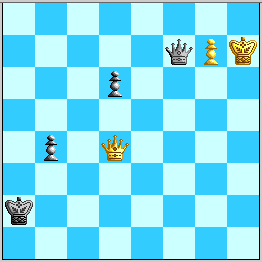
Diagram 7, White to move. How do you win now???
Now 62. Qxb4 allows an instant perpetual, and 62. Qh4 allows the loophole 62...Qf5+ 63. Kh8 Qe5, and this strong centralized position and pin seems to be a draw in cases like this. White can box Black out only by getting his Queen to g5, and as the only check in the position helps White get there, let's play it:
62. Qd2+ Ka3
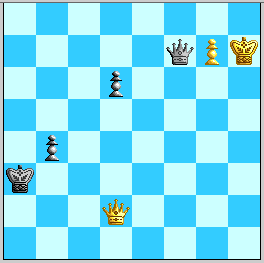
Diagram 8. Time to start counting...
However, 63. Qg5 is not in time: 63...b3 64. Kh8 b2 65. Qa5+ Kb3 66. Qb5+ Kc2!=. This does explain why Black avoids playing to a2 or b3 next (e.g., 63. Qc1+ Ka2? 64. Qg5 Qb7 65. Qh4 any 66. Kh8+/-).
63. Qc1+ Ka4

Diagram 9, White to play. And now??
64. Qc6+! Ka3
Here 64...Kb3!? is cagey and seems answerable only by 65. Qe4!, when 65...Ka3 66. Qa8+ transposes to the main line, and other moves by Black lose more quickly. And 64...Ka5 loses by ideas similar to the main line. Here is the analysis:
B21) 64...Ka5? loses as follows: 65.Qa8+, and now:
B211) 65...Kb6 66.Qd8+ Ka6 67.Qxd6+ Ka5 (67...Ka7 68.Qe5, wins for White) 68.Qg6, winning.
B212) 65...Kb5 66.Qf8 Qh5+ 67.Kg8, with:
B2121) 67...b3 68.Qf1+ Kb4 (or 68...Kc6 69.Kf8 Qh6 70.Qc4+, and White wins, or 68...Kb6 69.Kf8 Qh6 70.Qf5 b2 71.Kf7, winning) 69.Qf4+ Kc3 70.Kf8 b2 71.g8=Q b1=Q 72.Qgc4+ Kb2 73.Qfd4+ Ka3 74.Qa4 mate.
B2122) 67...Qd5+ 68.Qf7 Qa8+ 69.Kh7 Qe4+ 70.Kh6 Qe3+ 71.Kg6 Qg3+ 72.Kf5! Qe5+ 73.Kg4 Qe4+ 74.Kg5 Qe3+ (74...Qg2+ loses to 75.Kf6) 75.Qf4 Qe8 76.Qxd6, is a winning endgame for White.
B22) 64...Kb3 65.Qe4 , with:
B221) 65...Ka2 66.Qg6 Qe7 67.Qg4, and White wins.
B222) 65...Ka4 66.Qa8+ (66.Qc6+ repeats the position) 66...Kb5 transposes to 64...Ka5 65.Qa8+ Kb5.
B223) 65...Qh5+ 66.Kg8 d5 (66...Kc3 67.Kf8 Qh6 68.Qf5, White wins) 67.Qd3+ Kb2 68.Kf8 Qh6 69.Qf5 Qd6+ 70.Kf7 Qc7+ 71.Kg6 Qg3+ 72.Qg5 Qb8 73.Kf7 Qc7+ 74.Qe7, and White wins.
B224) 65...d5 66.Qe5, wins for White.
B225) 65...Ka3 66.Qa8+ Kb2 transposes to 64...Ka3 65.Qa8+ Kb2.
65. Qa8+ Kb2
Now (B231) 66.Qg2+ Ka3 67.Qg5 transposes to 63.Qg5 which is fine for Black. A funny White try is
B232) 66.Qa5 and now:
B2321) 66…Qb7, with:
B23211) 67.Qh5 Qe4+ (67...Qe7? loses to 68.Qh2+ Ka3 69.Qf4 b3 70.Kh8) 68.Kh8 Qd4, equal.
B23212) 67.Qf5 Qh1+ (67...Qe7 loses to 68.Qf4) 68.Kg6 Qg2+ 69.Kf7 Qb7+ 70.Kf6 (70.Kg6 Qg2+ 71.Kf7 Qb7+ 72.Kf6 Qg2 transposes) 70...Qg2 71.Qf4 (71.Qh7 Qf3+ 72.Ke6 Qe3+ 73.Kxd6 Qd4+ 74.Kc6 Qc4+ 75.Kb6 Qd4+ 76.Kb5 Qd5+ 77.Kxb4 Qd4+, is a theoretical draw) 71...b3 72.Kf7 (72.Qd4+ Ka2 73.Qa7+ Kb2 74.Qf7 Qf3+, draw) 72...Qb7+ (72...Qd5+ 73.Kg6 Qg2+ transposes) 73.Kg6 Qg2+ 74.Qg5 Qe4+ 75.Qf5 Qg2+, draw.
B23213) 67.Qg5 Qe4+ (67...Qh1+ loses to 68.Kg6 Qe4+ 69.Kf6 Qf3+ 70.Ke6 Qe4+ 71.Kxd6) 68.Kh6 Qe6+, equal.
B23214) 67.Kg6 Qe4+ 68.Qf5 Qc4! and Black holds (but not 68…Qg2+ 69.Qg5 Qe4+ 70.Kf6 Qf3+ 71.Ke6 Qe4+ 72.Kxd6, and White wins the endgame). Instead Black holds more simply with:
B2322) 66...b3! 67.Qg5 Kc2 68.Kh8 b2, and a draw.
However, White can extract a win from the position with:
66. Qf8!! ...
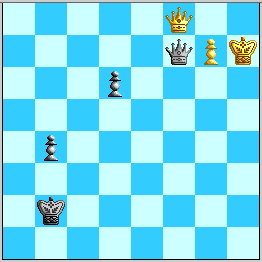
Diagram 10. Fancy meeting you here...
B233) 66...Qh5+ 67.Kg8, and now:
B2331) 67...b3 68.Qf6+ Kc2 69.Kf8 b2 70.g8=Q b1=Q 71.Qc4+ Kd2 72.Qfc3+ Kd1 73.Qf1 mate.
B2332) 67...Qg4 68.Qf2+ Ka3 69.Qa7+ Kb2 70.Kf8 Qc8+ 71.Ke7, with:
B23321) 71...Qg4 72.Qf2+ Ka3 73.Qf7 Qe4+ (73...Qg5+ loses to 74.Ke8) 74.Qe6 Qb7+ 75.Kf6 Qf3+ 76.Qf5 Qc3+ 77.Kg6 Qc4 78.Qf3+, winning for White.
B23322) 71...b3 72.Qf2+ Ka3 73.Qf8 Qc7+ 74.Ke6 Qc4+ 75.Kxd6 (later verified as EGTB+/- #22 when Karrer's b-pawn tables became available) b2 76.Kd7+ Ka4 77.Qa8+ Kb4 78.g8=Q Qd4+ (78...b1=Q loses to 79.Qb7+) 79.Qad5 Qa7+ (79...Qxd5+ loses to 80.Qxd5 b1=Q 81.Qb7+) 80.Kd6 Qb6+ 81.Qc6 Qd4+ (or 81...Qxc6+ 82.Kxc6 b1=Q 83.Qb8+, etc.) 82.Kc7 Qe5+ 83.Qd6+ Qxd6+ 84.Kxd6 b1=Q 85.Qb8+, and White wins.
B2333) 67...Qh4 68.Qf1! and now:
B23331) 68...Qd8+ 69.Kf7 Qd7+ 70.Kf6 Qd8+ 71.Kg6 Qe8+ 72.Qf7 (a case of the basic Qf7 win) Qe4+ 73.Kg5! Qe5+ 74.Kg4 Qe4+ 75.Kf3 Qe3+ 76.Kg2 Qe4+ 77.Qf3, and White wins.
B23332) 68...Qe4 69.Qf6+ (or 69.Qf2+ Ka3 70.Qa7+ Kb2 71.Kf8, winning) 69...Kc2 70.Kf8 Qa8+ 71.Kf7 Qb7+ 72.Kg6, and White wins.
B23333) 68...b3 69.Kf7 Qh5+ 70.Kf8 Qh6 71.Qf5, winning for White.
B2334) 67…Qd5+ 68.Qf7 enters the basic Qf7 win. A sample line is 68...Qa8+ 69.Kh7 Qe4+ 70.Kh6 Qe3+ 71.Kg6 Qg3+ 72.Kf5! Qe5+ 73.Kg4 Qe4+ 74.Kg3 Qe3+ 75.Kg2 Qe4+ 76.Qf3 Qg6+ 77.Qg3 Qe4+ 78.Kf1 Qc4+ 79.Kg1 Qg8 80.Qf2+ Kc3 81.Qf8, and White wins.
Note: The above analysis has not yet been subjected to rigorous independent testing. But if it stands, then IM2429's magnificent puzzle has a unique solution, and after 54. Qf4, Black's only holding move was 54...Qd5!